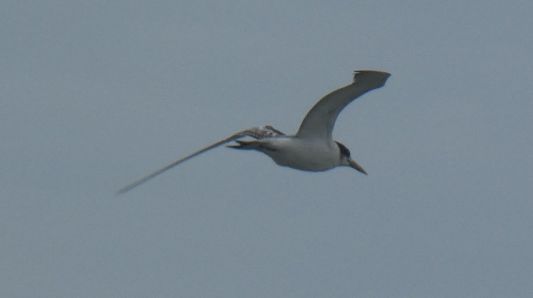The clouds have cleared temporarily. We have a pleasant view to the north.
Our planning reveals we are a tad early. Lakefield National Park is either totally booked out or not yet open. A look at roads reveals Lakefield Road is not yet open.
We decide to head north to the Cape in a few days, camping where we can on the way, then make our way south slowly. We have a map of mobile phone coverage, and also our satphone, so are confident we can book campsites in national parks.
There are a couple of campers and the track further along the beach is a bit tight, with overhanging trees, for us.
We parked at the entrance and walked along the track, just in case. As the track became overgrown we headed to the beach. By chance we met the rangers coming the other way, in the 4wd buggy. The beach is solid. Further along are a few campsites accessible from the beach.
We adjusted because the angle became worse as the wind blew sand from under the left rear wheel.
Fascinating watching them burrow into the sand when they become tired of running away. The dig a small hole then turn upside down to cover themselves.
We'll stay another couple of days. Hopefully the wind (its really quite strong) will subside. We are comfortable, but apparently Hughenden, many km inland, is suffering "wind chill".
There's something interesting about a sea churned up by the wind.
Overnight the sky was cloudless, we could see the stars. This morning the clouds returned, but also signs of clearing.
There are a couple of bouys beyond the low tide mark, probably marking more pots.
I saw only one after this encounter.
It did occur to me that a crocodile may find this little cove as enticing as I. I don't know enough about their habits. Some time during my walk it occurred to me that we usually see pictures of fully grown, several metre long, crocodiles, I wonder where all the small crocodiles are? I wonder what size they are before they think of tackling humans.
The patterns that the roots make are fascinating. As I retreat.
Food for the herons seemed to be small crabs. There are lots about. There's what may be a patch of sea grass, though it isn't just poking through the muddy sand that's been captured.
The two beaches together form Walsh Bay.
I usually have difficulty taking pics of white birds. The detail of their feathers is usually lost in a bland whiteness. No amount of fiddling with aperture and shutter compensate. For some reason, today the light allows me to see some detail and gentle shadows.
This campsite seems to produce something new each day. Perhaps when the wind fades we'll see other than sea birds. We can hear some in nearby trees, but don't see them.
In the meantime we are being sand blasted. Its beautiful clean, fine, white sand. Each morning we move the truck forward a metre, pack the hole where the left rear wheel sat with sand, then move the truck back. Today I tried wet sand that may last longer. A bit of success with repairs just after we arrived, I found the loose connection that slowly reduced the amps from alternator to house batteries - it was one end of the positive wire between the two starter batteries. The engine now also starts just a little easier.
Solar was good yesterday, the house battery reached 85%. With the portable panels deployed. Interesting locating them so the sand blows off them rather than being deposited. Probably not so good today. We have one failed panel which is dragging down another, but far too windy to contemplate climbing on the roof to fault find or bypass it.
A short walk across our beach to the south side. I'd seen one beach stone-curlew wondering about the beach. At the far side I saw two, and thought "how nice, they are together again". And then confusion .... there are three.
I failed to find a fifth ....
The bird book, which must be right, describes them as uncommon, usually singly or pair.
I think I'm privileged.

Possibly a visitor from Lake Baikal, or Kamchatka. Happy to be away from the northern winter.